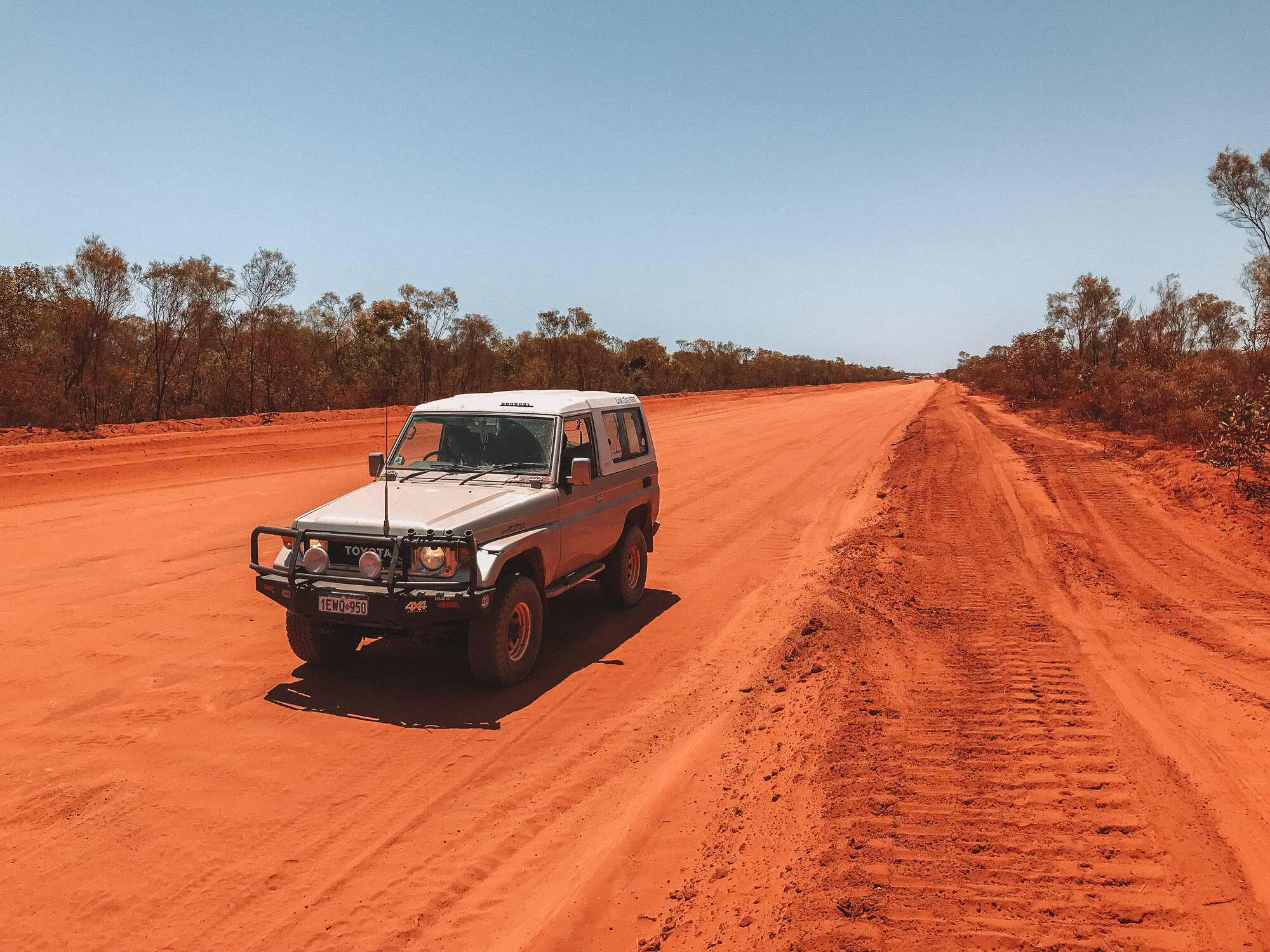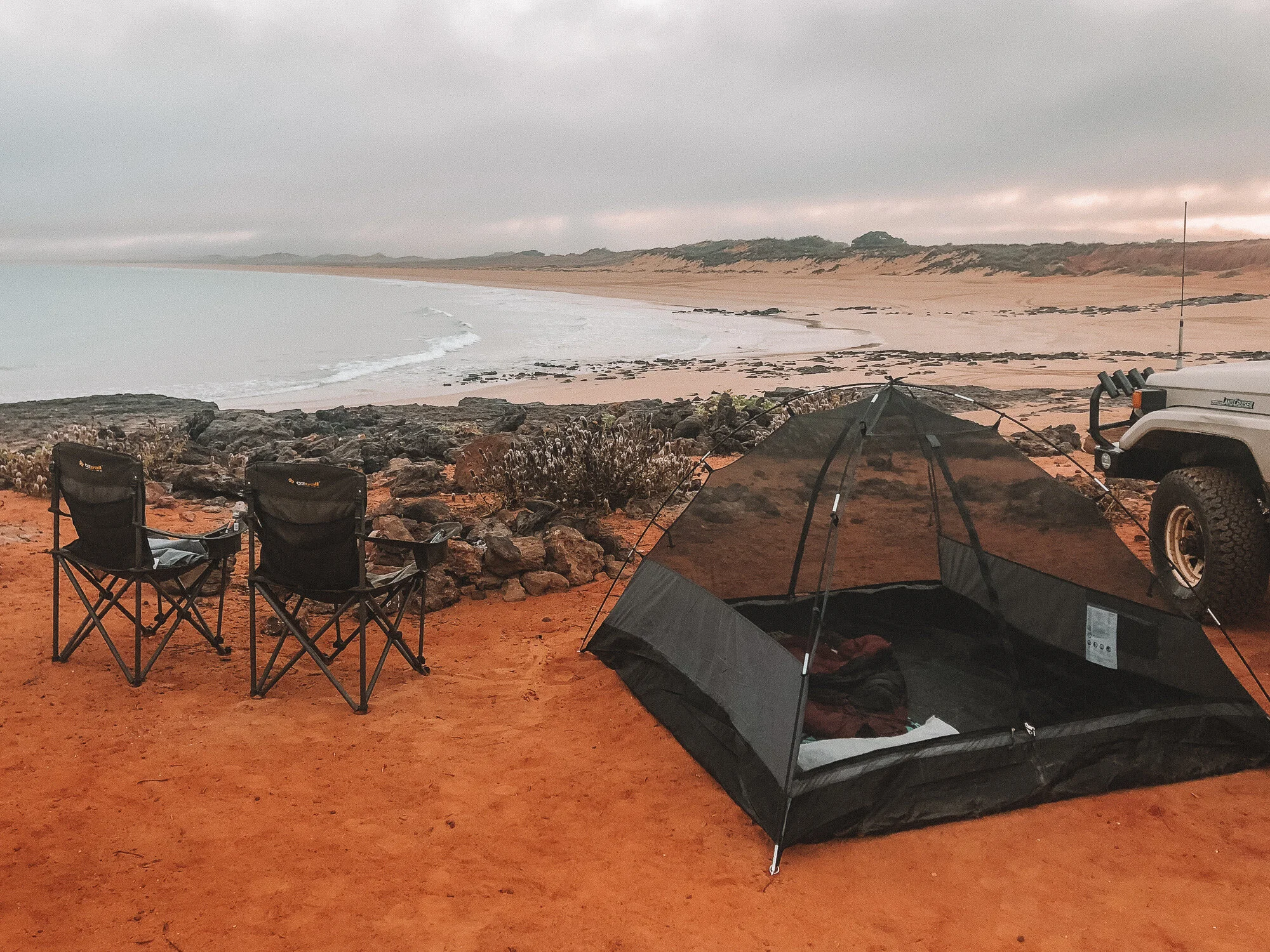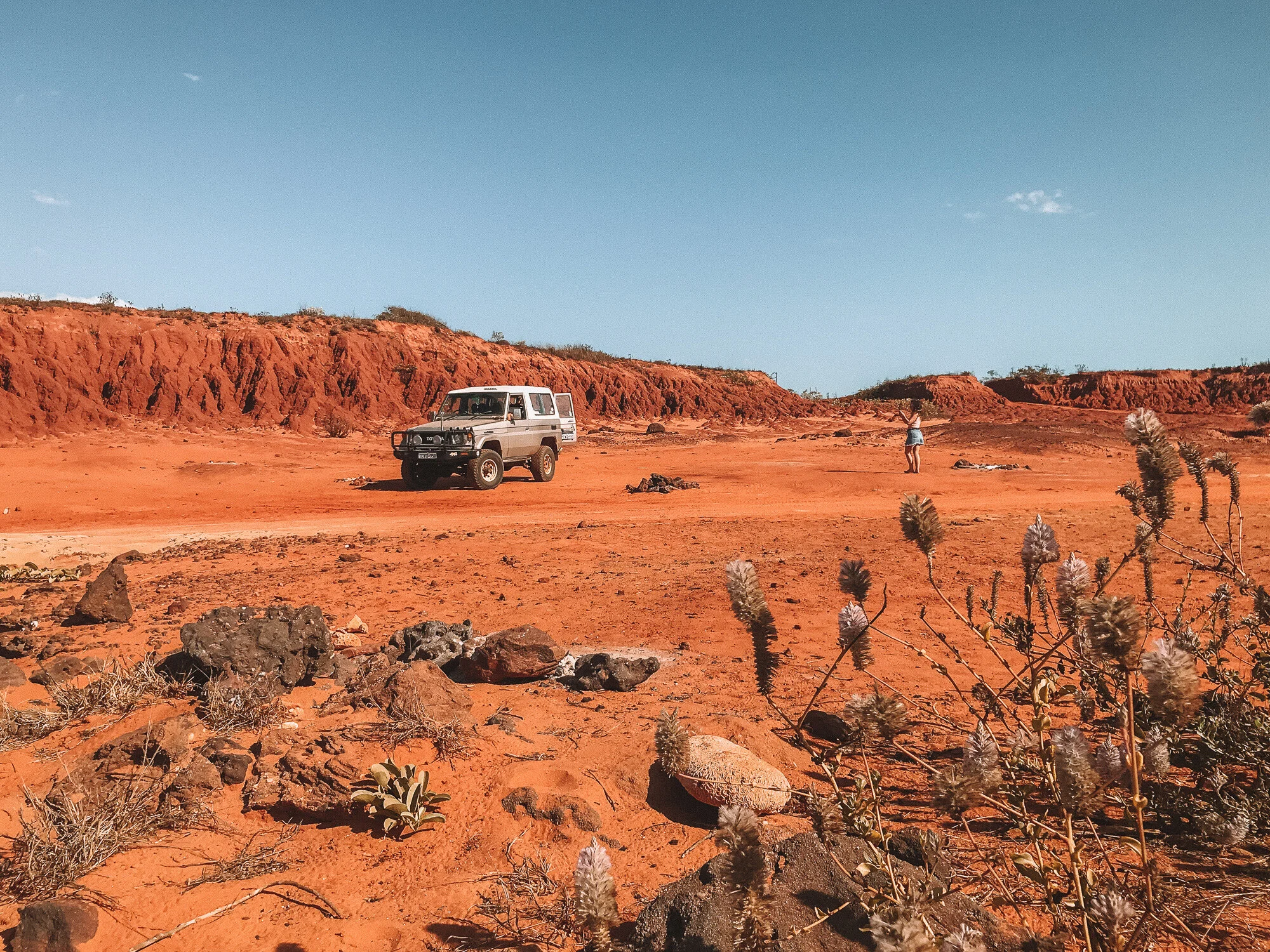Pender Bay. Pic by R. Saxby.
“Now is the time to explore the stunning Dampier Peninsula north of Broome. Now that the Cape Leveque Road is sealed, the beachfront campsites, amazing fishing and rich Ardi culture are so much more accessible to everyone. After visiting the peninsula since I was a teen growing up in Broome, I’ve hand-picked my top 6 spots to camp along this glorious stretch of the Kimberley coast.”
Pender Bay. Pic by M. Connell.
Ardi / The Dampier Peninsula
In the local indigenous Bardi language, Ardi means ‘northeast’. There are few places in Australia that have a richer sense of traditional indigenous culture than Ardi / the Dampier Peninsula. You can enjoy pristine, empty beaches and breathtaking coastal vistas on a camping budget, plus meet some of the amazing local people that call this region home.
Now that the road is sealed, there’s no better time than to head up the peninsula!
BYO grog: Anyone who’s travelled the Kimberley will have noticed the devastating effect that grog has had on some communities. The Dampier Peninsula is a restricted Dry Zone. BYO is welcome, but be respectful of local indigenous cultures with your grog consumption, or better still, try going dry yourself while visiting the peninsula!
Western Beach, Cape Leveque. Pic by M. Connell.
1. Kooljaman at Cape Leveque
2023 update Kooljaman is currently closed, until further notice
Since Cape Leveque is probably the best known spot on the peninsula, let’s start from the top and work our way south.
Read more in our book 100 Things To See In The Kimberley. The guide written by a local for travellers who aren’t ‘tourists’
Kooljaman is an off-grid wilderness camp about 220km north of Broome, in the heart of Bardi Jawi country. It is 100% indigenous owned by the two surrounding Aboriginal Communities of Djarindjin and Ardyaloon (One Arm Point). Famous for its rugged red coastal cliffs and rustic beachfront camping, Kooljaman is a must-stop spot for anyone exploring Australia’s North West. There’s a campground, safari tents and cafe/restaurant. The whole place is amazingly all powered by solar power and local bore water.
Beach shelter. Pic by M. Connell.
Accommodation: Choose between luxe safari tents; ensuited cabins; powered or unpowered campsites or (our personal fave) beach shelters. The beach shelters are adjacent to the eastern beach and comprise of a basic timber structure with palm frond roofing. $140 a night for a basic shelter may seem steep at first, but it's all about location location. Plus, Kooljaman's staff will even drop a crate of firewood to you.
Getting here: Travel north of Broome along Cape Leveque road for 220km (approx 2-3 hours) until you see the signage and turn-off on the left. The road to Kooljamin is now sealed, but plenty of the other roads in the area aren’t, so a 4WD is recommended.
When to come: Kooljaman is open year-round, however, I recommend avoiding school holidays.
The pindan highway before it was sealed. Pic by M. Connell October 2019.
The road as it was being sealed. Pic by R. Saxby October 2019.
Indigenous tour: An absolute must-do while you're visiting Kooljaman is a tour with local indigenous man Brian Lee. Brian is a larger than life character who was born and raised here. His tag-along tour of Hunter Creek will take you to the turquoise waters of the creek with plenty of stories and learning about traditional fishing, crabbing and bush tucker. Book through Kooljaman's office. $130 per adult from 8.30 until around 3pm. Your own 4x4 is essential.
“Brian is a larger than life character who was born and raised here. ”
Cape Leveque through the eyes of local man Brian Lee. Pic by M. Connell.
Exploring Hunter Creek with Brian Lee. Pic by M. Connell.
2. Lombadina
Just south of Kooljaman on Thomas Bay is the seaside community of Lombadina, which welcomes visitors with tours, accommodation, a bakery and a gorgeous bush church constructed from corrugated iron. At the arts and crafts centre, visitors can view and purchase souvenirs that are unique to the region, such as traditionally carved pearl shell.
If you're feeling hungry, grab some fresh bread (Monday, Wednesday and Friday) from Lombadina's bakery which has been in operation for over 25 years.
There's a range of tours to join at Lombadina including mudcrabbing, kayaking and fishing. It's $10 for a day visit, payable at the office upon arrival. If you need petrol, there's a roadhouse at the community's entrance (Djarindjin Roadhouse on Cape Leveque Road) with a few supplies such as sandwiches, fruit, icecreams and drinks.
Enjoy long stretches of empty beaches up the peninsula. Pic by M. Connell.
Accommodation: Choose between ensuited apartments, self contained cabins and unpowered bush camping. Bush camping from $50 per site, per night. Be sure to keep all valuables inside your vehicle.
Getting here: See above instructions to get to Kooljaman. Lombadina is just before Kooljaman's turn-off, approx. 200km north of Broome. When you see Djarindjin Roadhouse, turn left and follow the red dirt to the community.
When to come: Same as Kooljaman. During Wet Season, phone ahead with bookings and enquiries (08) 91924936.
Starry nights on the peninsula. Pic by R. Saxby.
Waterfall Reef, Cygnet Bay. Pic by Jampal of Salty Wings.
3. Cygnet Bay Pearl Farm
“Owned and operated by the Brown family for more than 70 years, Cygnet Bay is Australia’s oldest operating pearl farm. ”
Cygnet Bay pearl farm is just 15km north of Lombadina on the eastern side of the Dampier Peninsula, owned and operated by the Brown family for more than 70 years. Cygnet Bay is Australia's oldest operating pearl farm. The pearl farm recently opened their gate to tourists and they offer camping, glamping in safari tents, boat tours and a restaurant and pool that has sweeping views over the bay. Of course, they also have a pearl showroom and they offer tours that provide an insight into the South Sea pearls cultured pearling industry.
Accommodation: Choose between African style safari tents, pearlers shacks, the original Master Pearler's residence or a campsite which is $45 per night. Call (08) 9192 4283 to book.
Getting here: Cygnet Bay pearl farm is 220 kilometres north of Broome. Allow for at least two and a half hours of travel. Heading north on the Cape Leveque Road, the Cygnet Bay pearl farm turn-off is on your right just after the Kooljaman turn-off heading toward On Arm Point.
When to come: Bookings are essential in season (April to October). Call (08) 9192 4283 to book. Avoid school holidays.
Stunning pindan cliffs at Pender Bay. Pic by M. Connell.
Pender Bay Escape. Pic by Rachel Grixti.
Pender Bay Escape. Pic by Rachel Grixti.
4. Pender Bay Escape
I was hesitant about including this campground in this list, as I haven't actually stayed there myself, but photos from Pender Bay Escape are starting to pop up everywhere on social media now so I thought I'd throw it into the mix. A giant thanks to Rachel Grixti for supplying photos above. So, in saying this, I won't speak for the campground or the facilities. The location is tippy top, with gorgeous Pender Bay straight out the front. But you don't care about location, do you? You just want to know more about the bathtubs and the rockpool. Well, rightio then...
The bathtubs ... These are located on one of the campsites at Pender Bay Escape (a note to James at Cygnet Bay - remember when I suggested to you three years ago to put bathtubs on verandahs? Wink wink). Ask about this when booking your site.
The rockpool ... As I admitted above, I didn't go here. So, I'm going to copy and paste the description that Rachel Grixti used with this photo:
“Pender Bay’s hidden treasure. This little rock pool is tucked away and only accessible at low tide after a rock scramble around the headland. ”
Happy Humpback. Pic by Angela Batty.
5. Middle Lagoon
“Visitors return year after year, many of them towing boats and staying for weeks on end.”
The Howard family have been welcoming visitors to their low impact Nature's Hideaway at Middle Lagoon since 1996 and the word has definitely got out about the gorgeous beach and amazing fishing here. Visitors return year after year, many of them towing boats and staying for weeks on end. Facilities are very basic - take all of your rubbish with you and prepare for basic bathroom facilities. Nature's Hideaway at Middle Lagoon has a shop with bait, ice, drinks and icecreams; washing machines; showers and toilets with hot water depending on solar (get in well before it gets dark) and boat launching facilities.
If pristine swimming spots, great fishing and clear night skies are your thing, Middle Lagoon is the place!
Accommodation: Choose between cabins or unpowered campsites which are $20 per person, per night. If you're travelling in an off-road caravan or large camper trailer, call ahead so that the staff can allocate you a large site ph (08) 9192 4002.
Getting here: Nature's Hideaway at Middle Lagoon is 180 kilometres north of Broome. Allow for at least two and a half hours of travel. Heading north on the Cape Leveque Road, the Middle Lagoon turnoff is on your left after Beagle Bay. Middle Lagoon is 32 kilometres from the turnoff. As with the places listed above, you'll need a 4x4.
When to come: Bookings are essential in season (April to October). Call ahead to book ph (08) 9192 4002. Avoid school holidays, if possible.
Morning fog rolls over James Price Point. Pic by M. Connell in October 2019.
The road to James Price Point. Pic by M. Connell.
Read more in our book 100 Things To See In The Kimberley.
6. James Price Point (Waldamany)
The first thing that you’ll notice at James Price Point are the iconic red cliffs, which are even more dramatic against the backdrop of pristine white sand and turquoise sea. Stay still and look closer and you may spot the many reptiles, birds and mammals (including the endangered bilby) that call James Price home. Nesting sea turtles visit the area and humpback whales migrate past. There are many important Indigenous cultural heritage sites and you might spot dinosaur footprints in the intertidal zone too.
This is a popular drone spot, with the red dirt road running adjacent to the ocean and the dramatic cliffs separating the two. Drone around the high tide, when water is closest to the cliffs.
Accommodation: JPP / Waldamany is a popular free camping spot with a three day limit. You’ll need to be self-sufficient as there are zero facilities. Take all of your rubbish with you and don't leave toilet paper on the ground or in the bushes after you've used it. Yuck.
Getting here: JPP is just 50km north of Broome along a red dirt road (4x4 needed). Head north from Broome toward Willie Creek Pearl Farm and follow the signs to JPP.
When to come: April to October is the most popular time, when temperatures are cooler. But, you can come at any time of year as long as there hasn't been heavy rainfall that makes the dirt roads boggy. Check road conditions first with Broome Visitor Centre.
Read more in our book 100 Things To See In The Kimberley. The guide written by a local for travellers who aren’t ‘tourists’.
James Price Point. Pic by M. Connell.
Thanks for reading! Drop back from time-to-time and please - if any of the information has changed or if you know of more great spots - leave them in the comments below :)























